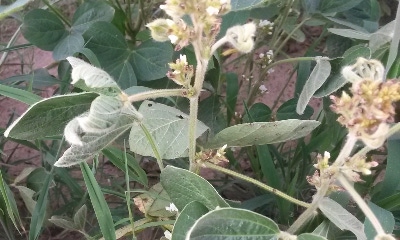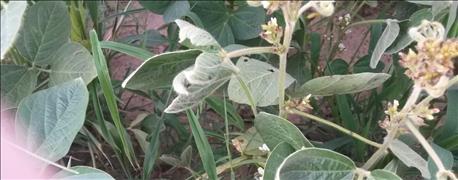
Mike Milam did not even need to get out of his truck to see the damage. He found fields where soybean leaves were tucked upward and appeared fuzzy and crinkled. "The fields look dismal from the road," the University of Missouri Extension agronomist for Dunklin County shares. "This is the worst case I have ever seen of widespread drift damage."
Related: Farmers deal with dicamba drift cases
The problem, Milam says, is a mix of farmers, technology and weather.
Roughly 100 complaints encompassing 18,000 acres are being investigated for possible herbicide injury in southeast Missouri.

CAUSE AND EFFECT: Dicamba drift could be the cause for damage to soybeans in Missouri.
Famers in this region are battling palmar amaranth and waterhemp popping up in their fields. "We have it so badly, that farmers are pulling out all the stops to combat these weeds," says Sam Atwell, University of Missouri agronomist for New Madrid County.
These weeds are so prolific they are resistant to glyphosate. "So post spraying of products like Roundup is failing completely," he adds.
Atwell notes that old pre-emergent chemistry that was put into the soil was hit or miss. Adding that farmers turned to over the top herbicides that would either cause injury or put a drag on yields. Plus, it was expensive to make several over trips over the field.
The new Xtend technology in both cotton and soybeans would allow for dicamba to be sprayed over the top providing the weed suppression many farmers need.
"What we have is seed out here tolerant to spray technology but not labeled to be sprayed," Atwell adds.
Discovering drift
Milam was prepared for calls regarding dicamba drift to come in this year with the introduction of Bollgard II XtendFlex or Roundup Ready 2 Xtend Soybeans. What he wasn't ready for was the number of calls and amount of damage.
One problem the two MU Extension agronomists found is that farmers affected by the dicamba drift do not know how much of the product was sprayed. Making matters worse is the type of so-called drift. With the number of acres affected, the drift does not appear to be direct from adjacent fields.
The likely culprit is dicamba drift. However, it may not be a direct drift event. Missouri's weather and old technology could have teamed up to create the extensive reach of crop injury, affecting not only soybeans but also specialty crops.
"The drift is so light, it is like a phantom drift," Atwell explains. He notes that these types of drifts are difficult to pinpoint origin. The humid summer days combined with old dicamba technology that could be from as many as 50 years ago, may have created a scenario where the chemistry volatilized, got up and moved.
Current dicamba technology does not volatilize in the same manner as old technology. "You just had farmers who were using old technology and it is not designed for today," Milam says. He notes that if the Environmental Protection Agency would approve the newer technology, perhaps farmers would not be using the other generic dicamba that volatilizes more rapidly and spreads differently.
Spraying any dicamba product over the top of Bollgard II XtendFlex or Roundup Ready 2 Xtend Soybeans is illegal because neither is labeled for use and any use would be against the law at this time. But Atwell says farmers in this area are facing immense weed pressure.
And while illegally spraying dicamba on Xtend soybeans and cotton can help that farmer with weeds suppression, farmers with acres still not planted to the Xtend technology are vulnerable for dicamba injury if drift occurs. Ultimately, it hurts the bottom line.
Potential yield loss
The amount of damage farmers experienced and when it occurred may dictate potential yield loss. According University of Missouri Extension weed scientist Kevin Bradley it all depends on what stage the soybean plant was at when the herbicide injury occurred. He spoke in 2014 on dicamba drift during a field day. Farmers will see injury and cupping at every rate sprayed by dicamba. "When we spray this early in the season on soybeans, and drift onto them or tank contamination or volatility or whatever, this does not necessarily translate into yield loss," he noted.
In MU research trials, soybeans sprayed at V3 did not end up with yield loss. However, at the R2 growth stage, it took just .0025 pounds of dicamba before causing a 9-bushel yield loss. So, just .08 ounces to the acre of dicamba can cause a 9-bushel loss.
The Missouri Department of Agriculture's Bureau of Pesticide Control continues its investigation to identify the cause of the herbicide injury that affected thousands of acres in southeastern Missouri.
About the Author(s)
You May Also Like






